Final report for GNE16-127
Project Information
This grant set out to determine the efficacy of beddings made from common biomass buffer species found in the Northeastern U. S. through two trials. The first set to determine if switchgrass processed to a smaller particle size would perform as well as switchgrass processed to a larger particle size. The second evaluated green biomass willow chips to determine if this bedding would perform equally to kiln-dried softwood shavings.
The willow project deviated slightly from the grant’s intended purpose of testing two sizes of biomass willow chips because when we started sourcing chips for the project, it was realized that there is only one type of commercial willow cutting head in the region, which, although can produce chips of varying size, there is only one that is accepted by industry. This resulted in a shift of this trial’s focus. Since field-scale trials comparing willow to softwood shavings had not been performed to date, this was a viable alternative project that would still provide useful information for those looking to use willow as an alternative bedding source. Both projects were performed at our cooperator’s facilities to see how these beddings would perform in the field.
Two identically designed houses, each containing three replicate cells per treatment, were used for the switchgrass trial, while only one house was used for the willow. The projects’ house design differed from the one originally proposed due to opportunities, conversations with the cooperator, and a power analysis. The outcome of these changes resulted in a better statistical power and fit with our cooperator’s goals, while still providing the best potential for sound scientific methods. One house was used for the willow study due to economic constraints.
Bedding performance, litter performance, bird performance, and bird welfare parameters were tested. Each bedding material was tested for moisture, pH, bulk density, water holding capacity, evaporative loss, particle size distribution, nutrient composition (total N, ammonium N, organic N, P2O5, K2O, C and the C:N), and energy value. Once in the house, the litter was tested at the end of brooding (day 12 and 9 for switchgrass and willow, respectively), 5 weeks, and 7 weeks. Litter parameters evaluated included moisture, pH, litter surface temperature, house ambient ammonia, and litter scores for all periods evaluated. At the end of each trial, litter samples were taken for nutrient and energy analyses and the litter surface was tested for ammonia flux. A sample of birds was evaluated from each replicate cell for bodyweight, breast cleanliness scores, and footpad scores. Mortality was tracked during the brooding period.
It was concluded that both alternative beddings will perform well over the course of a single-cycle broiler grow-out. The results indicate that each of the beddings tested have considerations that should be made before determining which to use in an individual production scenario.
The educational approach intended to introduce the results of this study to both the farming and scientific communities, which would simultaneously create interest and adoption as well as prompt future research efforts and recommendations for these types of alternative beddings. The farming community was reached most notably through a booth at Ag Progress Days, where fliers about the project’s results and bedding samples were on display. This event was open to both the farming community and the general public, so it presented an opportunity to reach both audiences. Communications with and a presentation given to the Association of Warm Season Grass Producers allowed for these growers to understand the needs of the commercial poultry industry and prepare them to create a product that would be successful in this market. A local 4-H organization, which had begun using switchgrass under their club birds after hearing about this project’s research goals, was interested in learning more about it. In response, a presentation was given at one of their poultry focus meetings that covered production of the biomass, general project results, and recommendations for product use for hobby-type flocks. Two presentations regarding the two trials in this project were presented at the 2017 Poultry Science Association meeting to poultry scientists nationwide. A symposium paper will be published in the Journal of Applied Poultry Research, reflective of the symposium presentation.
This project revealed more about the potential of biomass buffer species to work as a bedding for single-cycle broilers. It also brought to light some of the processing considerations for each alternative bedding tested (switchgrass and willow) and the selling price considerations for those producing it. Working through the various aspects of the project developed connections among groups that will further drive the production, processing, and use of these and other similar biomass materials.
Introduction:
Softwood bedding material availability and price in Pennsylvania has a history of fluctuating, leaving broiler farmers to pay a high price or not have the bedding they need readily available for their birds. Kiln-dried softwood shavings reliably perform as a functional bedding material; the bedding absorbs moisture quickly from the birds and eliminates it to the air to keep the moisture in the house low. It also cushions and insulates young birds. The nature of the shavings resists caking, which keeps breast feathers clean, footpads free from injury, and decreases ammonia volatilization potential in the house. These qualities are important when looking into alternative bedding materials.
Switchgrass and biomass willow offer biomass that can be used to combat these uncertainties. Both crops have been shown to grow successfully in the Northeast and can be grown on or near the farm to provide an annual or 3-4 year harvest of biomass bedding material. Not only does this alleviate concern surrounding the fluctuations and variability within the shavings market, but it also reduces biosecurity risks associated with bedding trucks entering and leaving the farm and reduces costs associate with a middle man and shipping.
Cost of the bedding is one important factor, but transportation costs can quickly add up when getting bedding to the farm. A more local product can offset transportation costs, while supporting the local agricultural community. A broiler grower survey conducted as part of this project gave insight into what broiler producers are paying for bedding and therefore what price alternative bedding suppliers would have to match to become competitive in the marketplace. However, once a bedding gets a foothold in the marketplace and is shown to perform better or equal to softwood shavings, the price can increase to a point where biomass farmers can make a reasonable profit, if originally underselling. This is especially important for those growing biomass species in PA, where small fields and lack of a stable market offer few profitable outlets for their product.
Willow and switchgrass stands were originally established as a source of alternative fuel in Pennsylvania. Because of the widespread distribution and number of farmers producing this material, there is availability of this product to farmers in the region. Both species can produce for 20 years, and having an alternative to the fuel market can increase the financial stability of those who have opted to grow them. These already established crop areas provide a great base for those looking to try bedding with these crops, but do not want to commit to growing them on farm as either part of a vegetative buffer or fuel crop.
If these species are grown on-farm, there are two options for processing. The grower may already have the equipment necessary to processes switchgrass, since it is processed similarly to other grass crops. The other option for switchgrass would be to hire a harvest contractor if the grower does not have the equipment or want the responsibility of harvesting his bedding. Willow, on the other hand, requires the use of specialty equipment and requires planning ahead to ensure a contractor with special willow harvesting equipment will be available for that year’s harvest. For either bedding, purchasing equipment or using a contractor may incur significant cost, so this should be evaluated before one decides to use an on-farm bedding resource.
Both species have the advantage of standing in the field from maturity up to the point of harvest. This reduces the need for large bedding storage facilities, especially in multi-cycle broiler operations, which bed once per year and reuse the bedding across multiple flocks. In the instance of switchgrass, the product can be harvested between late fall and before the start of spring. Regardless of when harvest commences, it can be cut, round baled, and stacked in the field, eliminating the need for bedding storage altogether. Willow is also available to harvest any time from late fall to spring, but cannot be round baled, so it must be stored in piles. These piles can be stored under cover or left in the open.
An additional advantage of switchgrass is that after the nutrients regress back into the root system and before the plants push forth new growth in the spring, the biomass dries down to less than 20% moisture. If the harvest is put off until early spring, it isn’t atypical for that percentage to be between 10% and 15%. Although willow does not dry to this ideal moisture, it is put in the house green, eliminating the need for additional drying. By eliminating the drying step for both materials, they can be provided at a price point similar to softwood shavings. It also makes on-farm processing of both materials more realistic if that’s the path a grower chooses.
Both of these species provide environmental benefits that result in a more sustainable agricultural system. The roots can stabilize otherwise soft or mucky fields and improve soil quality over their lifespan. These crops can be planted on land with high nutrient values as a remediation tactic. Requiring little added nutrients, they will take up whatever is in their environment, including potentially environmentally damaging phosphorous. As part of a vegetative buffer, they will trap emissions including dust and odor, thereby reducing the amount that leaves the farm. Additionally, they provide a living screen, which beautifies the barns, making them more acceptable to the public and minimizing scrutiny by those who share a community with the farm.
The processing equipment for willow has been relatively standardized, where it has not for switchgrass. Currently there is only one willow cutting head in the northeast. At SUNY-ESF, a New Holland FR9080 self-propelled forage harvester was used with a 130FB coppice header. Only one other cutting head exists in the region and it is the same model. Unlike harvesting biomass grasses, where adjusting the cutting head of a forage harvester or settings on a bale chopper can produce different effective end-use products, this machine is most efficient at the largest setting of 33 mm, which provides the most acceptable product for the variety of end-users. Because the equipment across the state has not been standardized for switchgrass bedding processing, variability in particle size will result. Particle size has been noted to impact bird welfare and the environment of broiler houses. The particles created by both pieces of equipment used in these trials were classified, providing a base from which others can produce similar products in the future.
Two trials were conducted at a commercial broiler production facility to determine the efficacy of bedding made from two common biomass buffer species. In the first trial, two particle sizes of switchgrass were compared to determine the most optimal particle size for commercial broiler production. In the second trial, green biomass willow chips were tested against softwood shavings to determine their viability as a bedding at the commercial scale. Both beddings were tested under broiler chickens reared to 7 weeks of age. The following objectives were explored:
- Classify the bedding materials used for each trial (chopped switchgrass, chopped biomass willow, and softwood shavings) based on particle size, pH, percent moisture, moisture holding/releasing capacity, bulk density, nutrient composition, and BTU content.
- Over the course of two separate grow-out periods, assign litter scores and evaluate litter .temperature, moisture, pH, nutrient content, BTU content, ambient ammonia, and ammonia flux.
- Evaluate bird performance between each of each trial’s beddings tested in terms of body weight gain.
- Determine if there is a difference in welfare scores (breast cleanliness and foot pad scores) of birds raised on each of the alternative beddings.
Cooperators
- (Educator and Researcher)
- (Educator and Researcher)
- (Educator)
Research
Bedding Processing:
Switchgrass bedding was supplied by Ernst Biomass (Meadville, PA). It was mowed in early November of 2015 and left out in the field until it was round baled in May of 2016. From there, it was field stacked until it was processed for our project in November. To get two distinct bedding treatments, the bales were run through a bale chopper, outfitted with screens. Because Penn State had shown in a previous pen trial that switchgrass bedding with an average particle length of 0.53 cm performed the same as kiln-dried wood shavings and differed most from beddings processed to either 3.15 cm or 6.27cm, the goal was to produce two beddings as close to these standards as possible. To accomplish this, the smaller treatment (S1) was created by processing the switchgrass through a 1.27 cm down screen and 2.54 cm up screen. The larger treatment (S2) was created by processing through a 2.54 cm down screen and 5.08 cm up screen. The beddings were shipped to the farm and immediately spread in the houses in preparation for the arriving chicks.
The willow bedding was supplied and harvested by the research team at SUNY College of Environmental Science and Forestry in mid-January 2017 using a New Holland FR9080 self-propelled forage harvester affixed with a 130FB coppice header. The green chips were shipped to the cooperator’s farm, at which point they were stored under cover in a 0.61 m high pile until the project began in an effort to help the chips release some of their moisture.
Because only one type of willow cutting head exists in the region, the opportunity to compare willow chips from two different pieces of equipment was not available. Although there are multiple settings on the cutting head, the 33 mm setting is most efficient, creating a product that is most acceptable to the end-users. Therefore, the willow bedding was compared against the grower’s kiln-dried softwood shaving control. Although this did not match the expectations outlined in the original project protocol, it still gave the opportunity to test this novel bedding at the commercial scale, which has not yet been done to date.
Barn Design:
Two barns at our cooperator’s farm were used for the switch project, while one was used for the willow. Each barn was 13.4 m x 152.4m, with the brooding area divided as seen in the figure below to yield 6 total replicate cells (3 per treatment). This division of the house allowed for a balance between the number of replicates needed for statistical analyses and the convenience to those working in the houses. Each bedding type was spread along one side of the house from the center with a bedding spreader, which allowed for a uniform bedding depth of 8.3 cm. The red and blue lines in this figure represent feed and water lines, respectively.

The houses were stocked with 20,400 or 19,900 (switch and willow trials, respectively) straight run white Ross x Ross broiler chicks. All birds were placed in the brooding section, where they were equally divided among the experimental cells until the end of brooding, at which point half of the birds in each cell were moved manually to the non-trial region of the house. This resulted in an ending stocking density of approximately 100 cm2/bird. The switchgrass trial began on December 6, 2016, while the willow began on April 18, 2016. Both trials ran for 7 weeks.
Sampling:
Bedding samples were taken after the beddings were spread in the house, but before chick placement. Fifteen grab samples were taken randomly from three regions of each bedding treatment after the bedding was spread, but before bird arrival to form a replicate. Each region resulted in a replicate sample.
There were three separate evaluations of litter performance and bird performance/welfare taken at the end of brooding (day 12 for the switchgrass trial and day 9 for the willow trial), 5 weeks (day 35 for both trials), and 7 weeks (day 45 for both trials, with sampling of spent litter and ammonia flux for the switchgrass trial occurring on day 46). By taking only one measurement before 5 weeks of age at a time when the birds need to be handled for movement anyway reduced the stress on the birds and saved resources.
Environmental and litter sampling took place at 3 regions in each cell between the centermost drinker and feeder lines, which were further apart than the drinker and feeder lines nearest the wall. Before any litter samples are taken, ammonia, temperature, and ammonia flux (at 7 weeks) were taken first as to evaluate undisturbed litter. Sampling here was most representative of each region without taking samples all around the cell. The results of each of the three measurements in each cell were averaged to one number, which served a replicate. Twenty-five birds from each cell were evaluated for bodyweight, footpad scores, and breast cleanliness scores. These birds were individually scored, which scores were averaged to one number for each replicate cell. By sampling this number of birds to find an average per cell, the effects of variation typically seen among members of the same flock were lessened. Both environmental and bird scores were taken at the end of brooding, week 5 and week 7.
Bedding:
Bedding is one of the largest factors to impact the environment of a broiler house. The goal of the bedding evaluations was to classify its properties in order to give specific recommendations on how to process biomass in the future to optimize bird performance.
Particle size was classified using a sieve shaker (W. S. Tyler Company, Cleveland, OH) that complied with the ASABE standard S319.3 (ASABE Standards, 2008). The shaker was set up with a series of screens which diameters which allowed for a dissection of the particle sizes, especially on the smaller end of the spectrum. Those screens were the following diameters: 12.7 mm, 6.35 mm, 5.66 mm, 4 mm, 2.38 mm, 2 mm, 1.7 mm, 1.18 mm, 1 mm, 0.71 mm, 0.25 mm, 0.18 mm, 0.125 mm, and the bottom pan. The smaller end of the spectrum was evaluated more closely than the larger end because there is a tendency for some bedding materials to be excessively dusty, which poses a risk to those working with these potentially combustible particles, and can be unpleasant for those working in the house environment. Once the screens were stacked in descending order, the top screen was filled to a depth of 2.5 cm with sample and the shaker was run for 10 minutes. Following this, the particles held on the top of each screen were weighted, and a percentage of the total sample weight evaluated per screen was determined.
A moisture percentage was determined for all samples by placing samples of the same volume into a forced air drying oven set at 56°C for 48 hours. The innate moisture of the sample further classifies the material to give broiler growers an idea of the moisture they will introduce into their house with each material. It also provided a base from which to determine how the percent moisture would change over time.
Although knowing the moisture percentage of a bedding material can give a grower an idea of the moisture he will be adding to his house, laboratory analyses of moisture holding capacity and evaporative loss may be a way to predict how the bedding will behave in regards to holding and releasing moisture over the course of grow-out. The techniques used for these analyses followed those outlined by Spiehs et al., though instead of evaluating the bedding at all of the time periods this paper dictated, water holding capacity was evaluated at hours 0, 6, 12, 24, 48, and 72 hours while evaporative loss was evaluated at hours 0, 2, 4, 6, 12, 24, and 48 (2013). The number of time periods evaluated by Spiehs et al. was unrealistic for the labor we had, but the critical time points evaluated still attained enough data to get an idea of how the materials would perform over both processes.
Next, pH was evaluated using the techniques outlined by Benabdeljelil and Ayachi (1996). It has been shown that litter with a lower pH will have less ammonia volatilization and fewer injuries to the footpads from ammonia related burns. Many litter amendments acidify the litter for that benefit. If a bedding material has an acidic nature and is able to keep that nature over the course of grow-out, it will have the advantage of keeping a better environment within the house.
Bulk density is an important factor when considering volume per ton when ordering bedding materials. Many poultry growers order bedding by unit volume, however most producers of biomass tend to sell the material by the ton. The density provides a way to convert between both biomass bedding producer and end user. It also can be used to approximate the ending weight of litter that will need to be removed from the house.
Nutrient analyses and energy density were performed on the beddings to get a feel for their innate nutrient concentrations. If an exceptionally high value of a nutrient was present in the bedding, we wanted to determine if it would impact the nutrient density of the litter at the end of the cycle. Three representative samples were sent to Penn State University’s Agricultural Analytical Services Laboratory, University Park, PA for nutrient testing including total N, ammonium N, organic N, P in the form of P2O5, K in the form of K2O, and total C. A C:N ratio was determined from this data.
Samples were also sent to Barrow Agee Laboratories, LLC (Memphis, TN) for gross energy, determined by bomb calorimetry. Because some poultry producers burn their spent litter, we felt that knowing the energy value of the bedding without added feces would be helpful in selecting between types (switchgrass vs willow vs softwood shavings) if the end goal was to burn the litter to provide heat for the barns.
Litter:
Litter temperature was taken at the litter surface in each region of the cell with an infrared thermometer just prior to an ambient ammonia reading in those same areas. Ammonia samples were taken using a KWICK-DRAW Basic pump (MAS, Pittsburgh, PA) and one-use glass Drager tubes (DragersafetyUSA.com). At the end of brooding, tube style 12/a was used (measurement range: 2 – 30 ppm), while at weeks 5 and 7, 5/b style tubes were used because their range was greater at 5 – 100 ppm. This allowed us to more accurately follow changes in ammonia levels over the course of the trials. Litter temperature indicates the insulative properties of the beddings, while ammonia readings taken at the level of the birds are reflective of what the birds are experiencing.
At 7 weeks, a non-steady state flux chamber (surface area = 0.1338 m2; volume = 0.07172 m3) in combination with an INNOVA 142 Photoacoustic Field Gas – Monitor was used to measure ammonia flux. In order to calculate flux in the procedure outlined by Burley (2009), samples at each area were taken at 1-minute intervals for 4 minutes with a 2-minute downtime in-between to flush the previous sample from the chamber and to gather the next ambient ammonia at 54 cm above the litter surface. Ambient measurements can be compared to flux measurements to determine if they are influenced by the rate of ammonia release.
Litter scores were determined for each experimental cell by walking the entirety of the cell. The amount of caking was scored on a scale of 0 - 3, with 0 representing new bedding and 3 indicating litter which had severe caking over ≥80% of the cell’s surface. This scale moved by half point increments to further define the severity of cake.
Evaluating litter moisture and pH helped to quantify their changes at the end of brooding, 5 weeks, and 7 weeks. Grab samples in each region from the litter surface to the floor ensured representative sampling. The same analyses methods used for the bedding were used, with care taken to break up and mix the cake (if present) into the sample to ensure that the measurements were reflective of what was present in the house. These two measurements, combined with litter scores, ammonia readings, and bird welfare scores help to draw conclusions about how these factors influence each other.
At 7 weeks, samples of litter were sent to the two labs stated above for the determination of nutrient densities and energy. These reveal the end nutrient values of each litter type if applying immediately as fertilizer. The carbon analysis and resulting C:N ratio are of particular importance, as these values dictate if composting needs to take place before field application, as litter with a C:N near 30:1 will tie up valuable N from field crops as it decomposes unless first composed (Penn State Extension, 2016). If closer to 10:1, the litter would be ready for field application. The energy value is useful knowledge to those who burn litter, who may find that one contains more energy than another.
Birds:
Twenty-five random birds were captured in a mobile pen and individually weighed at the end of brooding, 5 weeks, and 7 weeks to determine if performance varies by bedding type. Only body weight was indicative of performance, as setup of commercial barns does not allow for feed intake and conversion data to be recorded by cell. Mortalities and culls during the brooding period are telling of livability thought that period, but on-farm limitations did not allow for recording outside of this period. Because the trials took place in only in the brooding section of the house, it was concluded that comparing records of the trial flocks to historical flocks would not yield any useful information, so this aspect to the original project was not conducted.
After weighing, each bird had its feet scored for lesions and breast feathers scored for cleanliness following the ranking system outlined in the Global Animal Partnership’s 5-StepTM Animal Welfare Rating Standards for Chickens Raised for Meat (Global Animal Partnership, 2012). The scores were modified to follow a more complex way of ranking that allowed footpads and breast feather cleanliness scores to be on the same scale. Both scales were 0 – 2, with 0 indicating either clean, intact foodpads or clean breast feathers and 2 indicating footpads with lesions that took up >50% of the main footpad and extended to the toe pads or adhesion of bedding and/or manure particles on >75% of the feathers. Each scale went up by 1/3 point increments to get a more exact designation for each welfare parameter. Both feet of each bird were evaluated, contributing 50 footpad scores for each cell’s average.
All data were analyzed via a one-way ANOVA using SAS 9.4. The results were blocked by house and significance was indicated at P ≤ 0.05.
Bedding Survey:
A group made up of broiler integrators from various regions of the state was brought together with the purpose of identifying cooperators for another project, “Poultry Manure Management in the Chesapeake Bay Watershed”. Under those cooperating integrators, growers who were identified to be responsive and willing to work with university representatives for the watershed project were selected for survey distribution. This method of selection ensured a high survey response rate.
Two surveys were created: one for the integrators and one for the growers. Both surveys were sent out on March 10, 2017, with a follow-up two weeks later. Because the integrators had received the grower survey to review as well as a request for permission to send the survey to the growers, some integrators completed the grower survey for their growers, while others sent the survey for the growers to complete. One integrator provided contact information to reach his growers by phone.
The integrator survey asked the following questions:
- Are farmers responsible for paying for their bedding material out of pocket or does each use an allowance from the company? If yes, what is that allowance?
- Are there restrictions on the type of bedding a grower can use?
- Are there seasonal restrictions on the use of new bedding material? (ex: cannot bed with new material in the winter months)
- Would you be open to your growers using a new bedding material source? If not, what would make you more open to use of a new bedding material?
The grower survey asked the following questions:
- How do you grow your birds? (Conventional? Organic? Antibiotic Free (ABF)?)
- How many flocks do you rear per year?
- How much bedding do you use to fully bed a house and what are the house dimensions?
- How long do you keep bedding under the birds/ how many flocks do you rear on one bedding cycle?
- Do you top dress your litter in-between flocks and if so, how much material do you use?
- What type of bedding do you currently use? (material, percent moisture)
- Do you have a preferred bedding type? Are there any preferred characteristics you are looking for?
- What do you currently pay for bedding? Does that price include delivery? Do you think that this price is too high, too low, or fair?
- What have you paid historically for bedding?
Literature Cited:
1.) ASABE Standards. 2008. Method of Determining and Expressing Fineness of Feed Materials by Sieving- ANSI/ASAE S319.4 (R2012). ASABE, St. Joseph, MI.
2.) Benabdeljelil, K. and A. Ayachi. 1996. Evaluation of alternative litter materials for poultry. J. Appl. Poult. Res. 5:203-209.
3.) Burley, H. K. 2009. Effects of reduced crude protein, amino acid balanced diets on performance, economics, and ammonia emission in a large-scale commercial laying hen flock. MS. Penn State Univ., University Park, PA.
4.) Global Animal Partnership. 2012. 5-StepTM Animal Welfare Rating Standards for Chickens Raised for Meat. Accessed May 2015. http://gapstaging.blob.core.windows.net/standards/5%E2%80%90Step%C2%AE%20Animal%20Welfare%20Rating%20Standards%20for%20Chickens%20Raised%20for%20Meat%20v2.0.pdf.
5.) Penn State Extension, 2016. The agronomy guide 2017-2018. College of Agriculture Extension Service, University Park, PA.
6.) Spiehs, M. J., T. M. Brown-Brandl, J. P. Jaderborg, A. DiCostanzo, J. L. Purswell, and J. D. Davis. 2013. Water holding capacity and evaporative loss from organic bedding materials used in a livestock facility. ASABE Annual International Meeting Paper No. 131595738. ASABE, Kansas City, MO.
Switchgrass Trial:
The difference in particle size distribution between the smaller (S1) and larger (S2) switchgrass beddings was one of the most obvious. In Figure 1, it was noted that there were a greater portion of larger particles in S2 vs S1, where there were more smaller particles for S1 over S2. The differences in the densities of the two treatments were supported by these results, where a higher volume of smaller particles in S1 resulted in a significantly higher density of 0.1039 g/cm3 vs 0.0728 g/cm3 for S2.
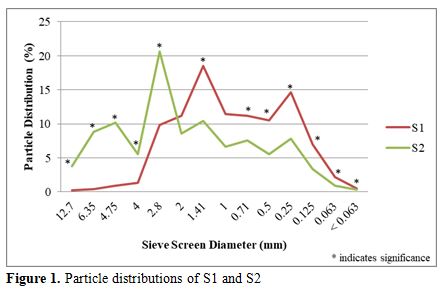
From the differences in particle size, it was expected that S1 would absorb water faster and hold a greater amount overall than S2, though would release it at a slower rate. This theory was not proven in the moisture holding test, as there was no difference in rate of and total saturation between the two beddings. However, the theory concerning evaporative loss was confirmed at hours 4, 6, and 12, where S1 retained significantly more moisture at those time points, meaning that it would release it slower than S2 over time, as seen in Figure 2. It was expected that this difference would result in S1 litter retaining more moisture than S2 over grow-out.

Because the two switchgrass beddings differed only in particle size, differences in moisture, pH, and nutrient analyses were not apparent between treatments. Although this was anticipated to be the case, if any significant difference were to exist, it would have a chance to impact the same litter parameters tested later on.
The grower really liked both switchgrass treatments when they were first put down in the house. Switchgrass’s “fluffy” nature was welcoming to the chicks and the bedding had a low amount of dust, which helped maintain the houses’ air quality. This opinion stayed through the end of brooding, at which point S1 was far outperforming S2 in regards to the degree of matting on the litter surface (Table 1). The longer particles of S2 created a network on which feces adhered to and stayed on the litter surface. The greatest difference in scores between the two treatments was noted at end of brooding (day 12). As the birds reached the end of a 5 and 7 week grow-out, the difference in scores was less, though the scores were unusually high, likely attributed to house environmental conditions.
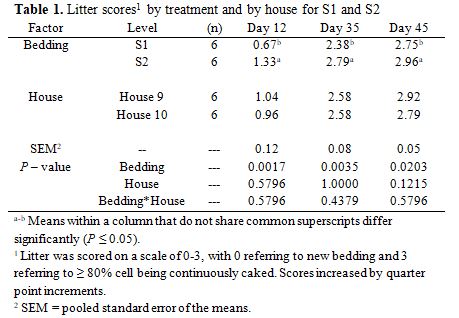
Footpad scores closely followed the trend of the litter scores (Table 2), where a higher litter score was associated with a higher footpad score. This trend has been noted by others researching this topic, including Cengiz et al., who stated that materials that wick moisture away from the birds create lower incidences of footpad dermatitis (2011). When the litter is caked, it cannot wick away moisture as effectively, resulting in the development of footpad lesions.
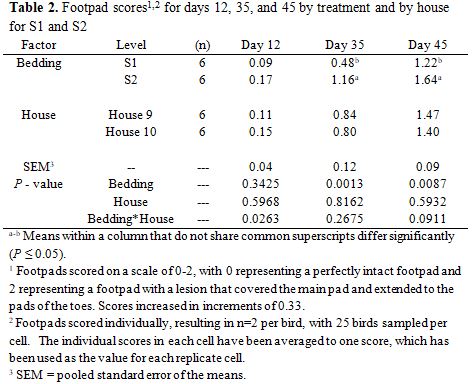
Although footpad scores were significantly higher for S2, there was no impact on live performance, even though the pain from footpad injury can result in decreased performance (Cengiz, 2011). The results of Bilgili et al. support the current study’s findings in that while footpad scores can be indicators of litter quality, they will likely not indicate a decrease in bird performance (2009). That being said, there is a large export market for chicken paws. Higher footpad scores indicate a greater number of severe lesions for birds on the S2 treatment, which may decrease in the salability of this product.
Breast cleanliness scores did not trend with litter scores, but instead followed litter moisture. There were no significant differences between scores of the two treatments for any of the evaluated days, but the scores did increase over time (Table 3). By the end of the trial, these scores were relatively high (1.24 vs 1.43 at 7 weeks for S1 and S2, respectively), but this was not surprising, given the fact that low winter ventilation resulted in little litter moisture being removed from the house. Table 4 shows litter moisture trended upward until week 7, where it trended down from week 5 measurements. This can in part be attributed to increased ventilation rates as the weather became warmer.
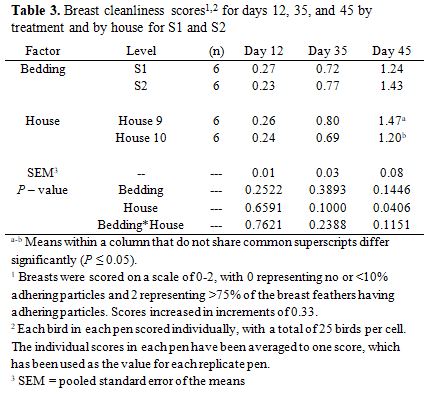
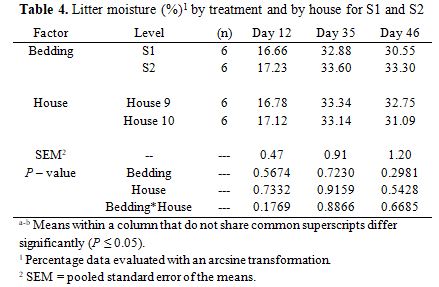
Ammonia volatilization is affected by temperature, pH, and litter moisture. Temperature has been noted to have the greatest effect (Miles et al., 2006), especially since litter not treated with an amendment (acidifier) typically does not control pH on its own. Therefore, pH of bedding is thought to be a small contributing factor (Miles et al., 2011). However, litter temperature was not different between treatments, nor was litter moisture. Unsurprisingly, there was no difference in ambient ammonia between treatments at the time periods evaluated (Table 5) or ammonia flux at 7 weeks (19.35 mg/m2/min for S1 vs 14.80 mg/m2/min for S2; P-value of 0.5969). That being said, ammonia levels were noted as high overall, but this was likely a result of low winter ventilation, drinker management, and lack of litter amendment use due to the house being organic, rather than the bedding materials themselves.
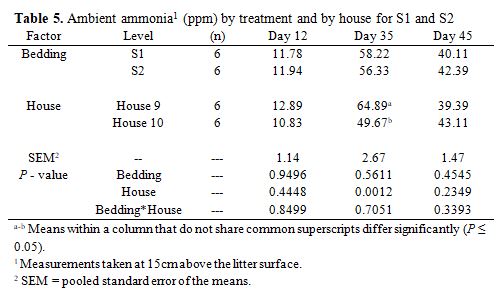
Even with higher litter scores and footpad scores on S2, bird performance was not affected by treatment (Table 6). This finding reflected that of Bilgili et al. (2009). Average bird bodyweight was significantly higher for S2 at the end of brooding, but this difference was made up by weeks 5 and 7, indicating that both beddings are equivalent in terms of bird performance. Overall mortality during the brooding period (days 1-9) was low for both treatments (0.76 and 0.67 for S1 and S2, respectively), further indicating that either material is appropriate when considering bird performance.
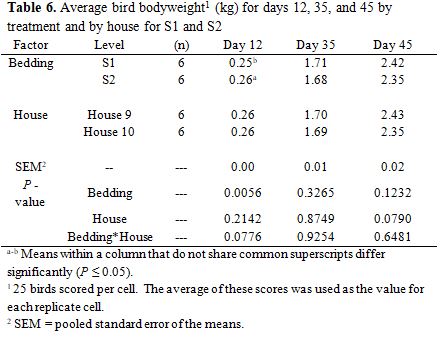
The nutrients in spent litter at 7 weeks (Table 7) indicated that nitrogen contents, including ammonium nitrogen, were not different, which agrees with our conclusion of no significant differences in ambient ammonia or ammonia flux at week 7 between treatments. Although potassium was higher for S2 over S1, there was no indication as to why this phenomena occurred, especially since nutrient levels in the bedding were not (P = 0.6649). When comparing the C:N ratios to the standards outlined in the 2016 Penn State Agronomy Guide, 13.23 (S1) and 10.91 (S2), although statistically different, are both appropriate for field application without composting. Both materials can be composed, but a substantial volume of carbon would be required to accomplish this process.
The significantly higher carbon content of S1litter was due to the initial density of the bedding material. The higher density of S1 meant that there was more carbon put down per cubic yard of bedding material than S2. If a grower was choosing to burn the spent litter to heat his houses, between 2.55 kg and 2.89 kg would equal the energy of 1 L of propane for S1 and S2, respectively. If the cost of the beddings were the same, it would make sense to purchase one with a smaller particle size, imparting a higher density to offset the dilution of carbon by the broiler feces, resulting in a higher heating potential per kg of litter.
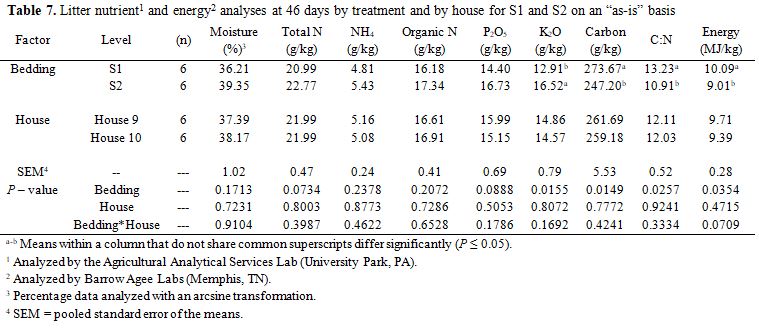
Willow Trial:
Unlike the two switchgrasses tested in the first trial, green biomass willow chips and kiln-dried softwood shavings are two innately different materials. One of the stark differences between the two was the size distribution (Figure 3) and particle shape. About 35% percent of the willow particles were larger than 12.7 mm whereas the percentage softwood particles of that size was just under 5%. Softwood had significantly more particles that fell between 6.35 mm and 0.71 mm, while both beddings had very few particles that were smaller than 0.71 mm. In regards to shape, the softwood was a shaving, whereas the willow was more of a chip. Willow pieces were either tubular, or fractured portions of tubular pieces, rather than a shaved product.
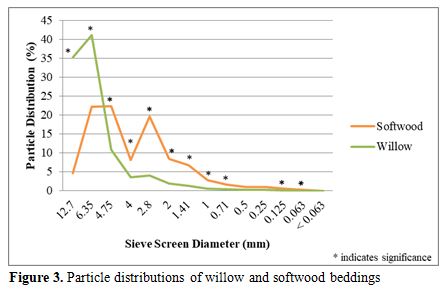
The particle size and material type strongly influenced both moisture holding capacity and evaporative loss (Table 8), where softwood held significantly more water at all time periods evaluated than willow. Willow held onto its moisture longer than shavings when compared for evaporative loss. For these analyses to be indicative of in-house performance, softwood would have to have lower litter moisture over the course of the trial, which would indicate that it would be better at wicking moisture away from the birds and releasing it to be carried out by the ventilation system.

Unlike the switchgrass, which was received very positive initial opinions, the grower was concerned about the willow even before the trial started; its large particle size and high moisture content are opposite of kiln-dried softwood shavings. The 9-week break in-between the time when the chips arrived and were spread in the house allowed time for the green chips to dry out. This process was expedited by the grower, who spread the load of chips (110 cubic yards) into a 0.61m high pile under cover for those 9 weeks. This resulted in the willow chips having lower levels of moisture (24.22%) than they would have if placed in the house immediately following harvest (37% - 51%) (Eisenbies et al., 2016).
A consideration that needs to be made for willow chips is by placing a material with high levels of moisture in the house, high rates of ventilation are necessary to eliminate that moisture so that it does not become part of the house environment. Because this trial was completed in April – June, ventilation rates were high, leading to very high success in the bedding which may have otherwise not been the case if this trial had been performed over the winter. This can be seen in Figure 4, where the moisture content of the willow decreased over the 9-day brooding period to match the softwood. This pattern may not be seen if this trial is replicated in the winter months due to the challenge of lowered ventilation.
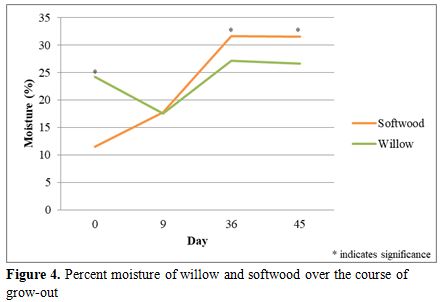
Litter moisture was significantly higher for softwood at weeks 5 and 7, though this did not correspond with higher ambient ammonia for this treatment (Table 9). This goes against what has been found concerning ammonia and litter moisture, where high litter moistures maintained over a period of 1-2 weeks can result in heightened volatilization of ammonia (Liu et al., 2007). An interesting item to note is that at week 5, ambient ammonia was greater for willow (10.00 ppm) than softwood (6.78 ppm). At week 7, although not significant, ambient ammonia was again greater for willow. This can be explained by the structure of the willow chip. Because chips are larger particles which can maintain their shape better than softwood, the ammonia that would otherwise by trapped by cake migrates out around the large particles, raising ambient ammonia at the level of the birds. This is further confirmed in that softwood had higher litter moisture at these periods, while litter surface temperatures were not significant. The same trend can be stated for ammonia flux, with softwood and willow maintaining values of 5.12 m-2min-1 and 6.70 m-2min-1, respectively, though the differences between the two treatments at 7 weeks were again not found to be significant (P = 0.4671).
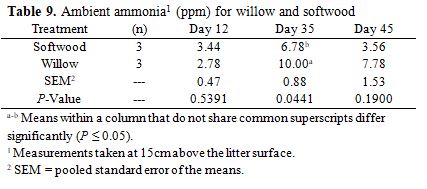
Although it was anticipated that the willow chips may be more acidic than softwood shavings, initial pH analysis, represented in Table 10, indicated that there were no significant differences between the two. This trend carried through the length of the trial. Both willow and softwood generally became more basic over time, but the lack of differences indicates that there is no advantage of one over the other for the maintenance of a less basic litter environment. The lack of differences in ambient ammonia verifies this observation, as pH is one of the driving forces behind ammonia volatilization (Miles et al., 2006).
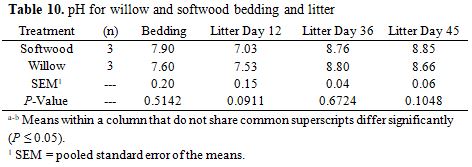
Litter scores were notably different between the treatments (Table 11). The level of caking in the house advanced slower for willow than softwood, and was maintained at lower levels overall. The structure and particle distribution played the largest role in this. Because the willow chips were more rounded and less prone to losing that shape due to particle fracture, the movement of the birds over the litter surface following defecation effectively rolled the particles of willow, moving the feces into a lower layer of the litter. When evaluated in the house, the litter showed stratification of particles, with the top layer being the largest, most rounded pieces of willow, whereas the bottom layer contained the small pieces of feces and willow that had made their way down from the upper layers. This bedding characteristic is a large advantage of willow bedding in that it truly resists surface caking.
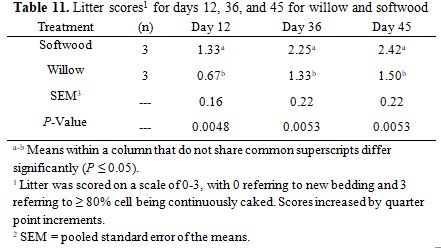
Lower litter scores for the willow did appear to keep footpad scores lower than those on softwood (Table 12), though it did affect breast feather cleanliness (Table 13). Footpad scores were low on both beddings, which can partially be attributed to increased ventilation and open sidewall curtains typical of late spring ventilation in PA. Because litter cake has been noted to increase footpad scores, birds on softwood should have had higher scores overall. This was not the case; the scores were not different. This observation could have been a result of the willow bedding having more rough or sharp particles, which may have induced more footpad lesions than softwood, which upon gross observation appeared to be a less abrasive bedding. Effectively, this made both litters even in regards to footpad scores. However, breast cleanliness scores were influenced by the level of cake, with scores at weeks 5 and 7 being significantly higher for softwood. This trend was not seen at day 9, which can be explained by the willow having a higher initial moisture with a more even mix of particles at that time, allowing adhesion of small particles to the breast feathers. When considering these two welfare parameters together, willow outperforms softwood.
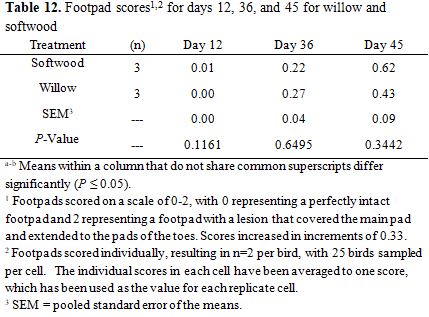
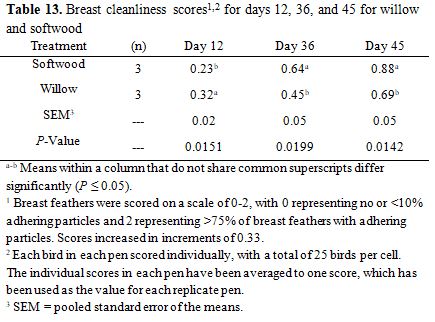
When evaluating bird performance, bodyweights were the same between treatments at all time points evaluated. However, mortality at the end of brooding was significantly higher for willow (P = 0.0153 data not shown). At 9 days, willow had 1.11% mortality whereas softwood had 0.73%. Mortality up to day 9 per day did not yield any statistically significant results by day, but willow did average higher each day, resulting in the difference overall. The Ross Broiler Management Handbook suggests keeping first week mortality under 0.7% (2014). At the end of 7 days, softwood had a mortality of 0.64%, while willow was 0.94%, which both approach and exceed this suggestion. It cannot be said if this trend continued or mortalities became balanced through grow-out because data was not kept on mortalities by treatment after brooding. Mortality should be evaluated over the duration of future trials to ensure that willow does not impart this significant disadvantage.
The predicted advantage of the softwood being able to hold and release more moisture over the course of the grow-out was not founded due to insignificance in litter moistures and the higher level of cake noted for this treatment. One idea is that because a flat softwood shaving is able to hold more manure on each particle’s surface, it matted over quicker than the willow, diminishing the effectiveness of its ability to release moisture more rapidly. This confirms that the laboratory analyses for moisture holding capacity and evaporative loss are not reflective of how these two types of bedding perform in the house.
Nutrient analyses of the bedding before bird placement revealed a greater level of ammonium N in the softwood (0.94 g/kg vs 0.17 g/kg) and more K2O in the willow (2.88 g/kg vs 1.53 g/kg). The carbon contents of the two were significantly different, with softwood containing 441.79 g/kg and willow containing 362.06 g/kg. The difference in carbon was not translated into a higher level of energy, in part due to the much greater moisture in the willow. At the end of the trial, the level of ammonium N was greater for softwood, indicating that levels of this bedding nutrient likely impacted ending ammonium N, since litter moisture, temperature, and pH indicated that the formation of ammonia would have been the same for both beddings. On the other hand, the difference in the K2O concentration of the bedding was diluted by the birds’ feces in the litter.
The results of the C:N ratio indicate that while both spent single-cycle litters can be applied directly as fertilizer, willow has a higher ratio, which may make it better fit for a composting scenario. Additionally, the larger willow particles will likely break down slower in the soil because of their smaller surface area to volume ratio, which should be considered if applying litter made from willow to the same field multiple years in a row. The buildup of this “slow-release” carbon may bind some nitrogen in future nutrient applications. The selection of which bedding to use may therefore in part depend on the grower’s nutrient management plan. The significant difference in the amount of carbon seen in the bedding was not translated to the litter because of the moisture loss of the willow over the course of the trial. However, there was a significant difference in the energy of the two beddings. When calculated, 2 kg of willow litter and 2.2 kg of softwood litter would be the energy equivalent of 1 L of propane. Burning these materials would result in energy savings for the farm as well as decrease the amount of nutrients that need to be removed from the facility by 90% (Farm to Manure Energy Initiative, 2016).
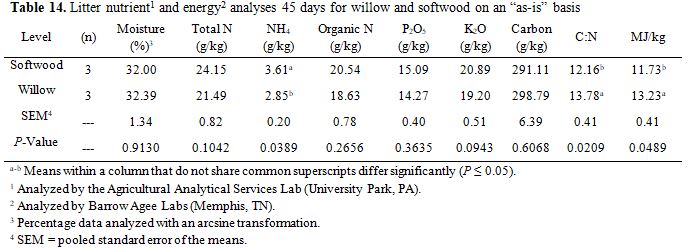
Reflective Note:
Overall, it would have been ideal to have bedding samples taken immediately following harvest and just before bird placement, as this would give an indication of the material’s moisture in both instances. Instead, the bedding material sampled for analyses was from just before chick placement after the house had been heated for a period of days. Although this gave a representative sample of the bedding at chick placement, the piece about the bedding moisture out of the field is left unsaid. For instance, switchgrass is typically found to be below 20% moisture (USDA-NRCS, 2011) and willow between 37% and 51% (Eisenbies et al., 2016) at time of harvest. We saw moistures of 11.09% – 11.18% and 24.22%, respectively. Kiln-dried shavings, which are expected to have less than 10% moisture, had 11.49% moisture at the start of the trial. While switchgrass was on par with the shavings, willow was substantially higher in moisture and would have been higher if put into the house immediately following harvest.
Bedding Survey Results:
Regarding response rate, six out of the nine integrators replied, representing six different companies in Pennsylvania’s broiler industry. Management styles represented included conventional, natural, antibiotic free (ABF), and organic. The responses collected varied by individual; some responses held a great level of detail while others were more generalized. The number of grower responses under each integrator varied between 0 and “several”, as noted in Table 15. Total grower responses numbed 11 plus “several”.
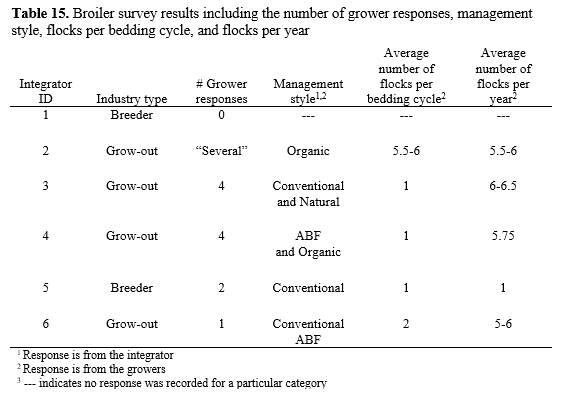
Bedding restrictions are commonly held by the integrator, noted in Table 16. Bedding materials are typically limited to kiln-dried softwood products, with restrictions put in place by the integrator for four out of the six companies. One integrator has an approved certified organic bedding supplier from which all grower beddings are purchased by the integrator. The integrator typically pays for the bedding in all but one instance, where the growers pay for their own bedding. Four out of six growers are willing to try alternative products so long as they don’t impact production, meet quality/performance standards, and are cost-competitive.
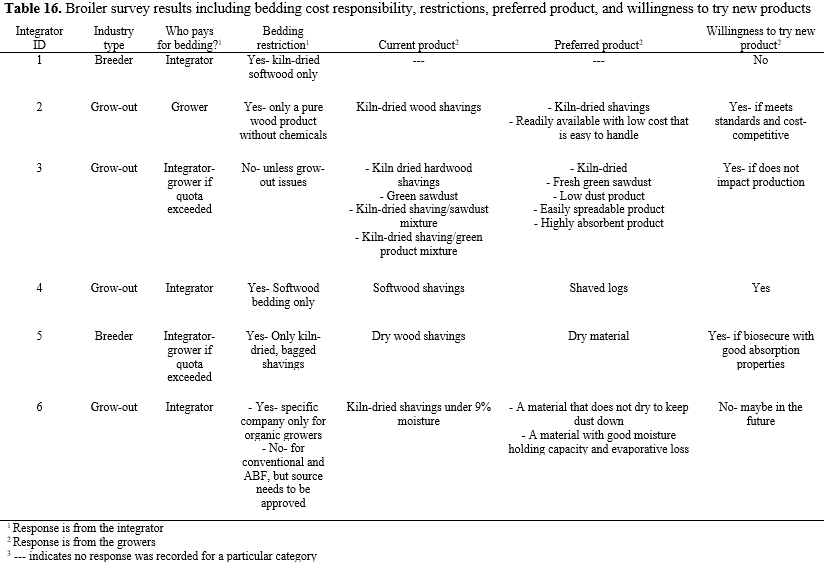
The price currently paid for softwood shavings in broiler grow-out operations is highly variable. That said, all include the cost of transportation, while some also include the cost of spreading. Table 17 highlights that the price paid for kiln-dried wood products can vary from $8.50 - $23.00 per cubic yard. However, most beddings average around $12.00 per cubic yard, which includes the cost of the product plus delivery. Including the cost of spreading does not result in a drastic deviation from this average value. The two broiler breeder operations surveyed did not respond with the current price paid for bedding, so this market cannot be commented on at this time.
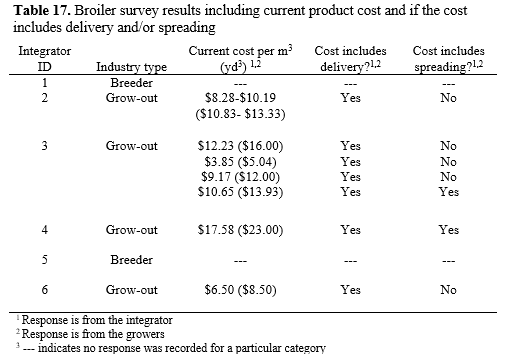
Literature Cited:
1.) Aviagen. 2014. Ross Broiler Management Handbook.
2.) Bilgili, S. F., J. B. Hess, J. P. Blake, K.S. Macklin, B. Saenmahayak, and J. L. Sibley. 2009. Influence of bedding material on footpad dermatitis in broiler chickens. J. Appl. Poult. Res. 18:583-589.
3.) Cengiz, Ö, J. B. Hess, and S. F. Bilgili. 2011. Effect of bedding type and transient wetness on footpad dermatitis in broiler chickens. J. Appl. Poult. Res. 20:554-560.
4.) Eisenbies, M., T. Volk, and J. Posselius. 2016. Research summary: characteristics of willow biomass chips produced using a single-pass cut-and-chip harvester. Accessed Oct. 2017. http://articles.extension.org/pages/71883/research-summary:-characteristics-of-willow-biomass-chips-produced-using-a-single-pass-cut-and-chip-
5.) Farm Manure Energy Initiative. 2016. Farm Manure-to-Energy Initiative Final Report. Accessed June 2017. https://articles.extension.org/sites/default/files/FarmM2E_Initiative_FinalRpt_MainBody_FNL.pdf.
6.) Liu, Z., L. Wang, D. Beasley, and E. Oviedo. 2007. Effect of moisture content on ammonia emissions from broiler litter: a laboratory study. J. Atmos. Chem. 58:41-53.
7.) Miles, D. M., D. E. Rowe, and P. R. Owens. 2006. Concurrent measurement of litter gas flux and nutrients with air and litter properties in poultry houses to improve emission estimates. Pages 914-920 in Proc. Workshop on Agricultural Air Quality, Washington D.C..
8.) Miles, D. M., D. E. Rowe, and T. C. Cathcart. 2011. High litter moisture content suppresses litter ammonia volatilization. Poult. Sci. 90:1397-1405.
9.) USDA-NRCS. 2011. Planting and managing giant miscanthus as a biomass energy crop. Technical note no. 4. Accessed Aug. 2015. https://pdfs.semanticscholar.org/d356/45ec6134d1b9a2749cd9f84f5c3ef08cdd17.pdf.
Overall, both chopped switchgrass and green willow chips can be employed as successful alternatives to kiln-dried softwood shavings in single-cycle production systems when considering litter performance, bird performance, and bird welfare.
From this project, it was determined some lab techniques are more telling than others when it comes to predicting how a bedding will perform over the course of a grow-out. Although moisture holding and evaporative loss analyses determined that S2 bedding would have a slight advantage over S1 because it would release moisture more rapidly, keeping the litter drier, this was not seen in the house. This was likely offset due to caking on the litter surface of S2 due to its longer particle size. Bedding density was reflective of the amount of carbon remaining in the litter after dilution with manure, influencing the C:N ratio and energy content of the spent litter. This disconnect was the same between willow and softwood, where softwood was expected to hold more moisture, but also release it to the environment faster than willow. While it did hold more moisture, the caking in this treatment reduced moisture release. It can then be concluded that density, particle size, and particle shape were more telling of in-house performance of bedding materials than moisture holding capacity and evaporative loss. Moisture holding and evaporative loss are not good methods for evaluating how a bedding material will perform in the house unless the size and shape of those materials’ particles are nearly identical.
Switchgrass is best for single-cycle commercial production when processed to an average size of 2.54 cm or less. This size cakes over less quickly and less overall when compared to switchgrass with an average particle length smaller than 5.08 cm, but greater than 2.54 cm, promoting better footpads. Parameters including litter moisture, litter temperature, ambient ammonia, breast cleanliness scores, mortality, and bodyweights did not differ significantly by treatment, indicating that with all else equal, the impact on the footpads is the deciding factor regarding one bedding size over another. However, if there is a large economic gain from using the larger chop size (fuel and transportation savings) and paw quality isn’t a great concern to the grower, the larger size can be used. This may be true especially in the warm months, when ventilation readily removes moisture from the house, which may mitigate the difference in caking between the two bedding types.
With green willow chips, a 33 mm chop length results in a wide range of particle sizes, allowing feces to sift to lower bedding layers from the top, reducing caking within the house when compared to softwood shavings. Better breast cleanliness scores at weeks 5 and 7 can be attributed to this as well as the stratification of particles, where large top particles did not adhere well to breast feathers. The lack of differences in footpad scores over the course of the trial indicates that the slightly more ragged nature of some of the willow particles may have injured the footpads, making scores equal to those of softwood shavings, even with softwood exhibiting higher litter scores. Developing a willow cutting head specifically for poultry bedding may help reduce the fracturing seen with the current model, providing less potential for footpad abrasion.
Green willow chips still need more commercial scale trials run to gauge grower acceptability and to determine if any seasonal constraints should be applied to this bedding. Because the trial was run during warm weather when house ventilation was high, it cannot be concluded that this bedding would perform equally well in winter, especially considering the amount of moisture it imparts to a house when compared to a kiln-dried product. For instance, the higher level of ammonia seen amongin birds on willow at week 5, although not found significant in our trial, may be exacerbated in a less ventilated environment. That being said, green willow chips perform better than softwood shavings in times of increased ventilation with results of lower litter moisture, better litter scores, and cleaner breast feathers at the end of grow-out with all other parameters excluding mortality at the end of brooding and ammonia at week 5 statistically equivalent. However, ambient ammonia and mortality should be evaluated closely in future trials to determine if this disadvantage is consistent for willow bedding.
Another consideration for the use of biomass willow chips is their availability. They are currently not easy to obtain in Pennsylvania due to the 3 - 4-year harvest cycle and rotating nature of specialized harvesting equipment. For these reasons, between choosing to utilize willow and switchgrass, switchgrass is the preferred species with its ease of harvest and further processing with readily available farm equipment. This is not to discourage use of willow, but instead to promote an increase in the numbers of established stands and harvesting equipment to make it more affordable and reliable than it currently is.
Significant differences in the nutrient densities of spent litter are a function of spent litter moisture content and bedding material density. The higher density of willow over softwood resulted in a greater amount of carbon per unit volume for willow in the litter, even though the amount of carbon was higher for softwood bedding on an “as-is” basis. The higher density of S1 over S2 resulted in a similar scenario, even though moisture contents for the beddings were statistically the same. Because of the higher density of the S1 bedding, the amount of carbon available in this spent bedding was greater because both treatments were applied to the same depth. Even with these differences between materials, when placed to a depth of 8.4 cm and single-cycled, all litters tested have the potential to be a valuable source of carbon, which can be utilized to offset propane costs.
When evaluating whether to compost or land-apply these nutrients, bedding type can make a significant difference. Bedding origin, type, and density all contribute to the nutrient content of spent litter. Larger switchgrass (S2) and softwood beddings have significantly smaller C:N ratios than do the S1 and willow. Therefore, S2 and softwood may be better for field application as fertilizer whereas S1 and willow can be used for field application, but may perform better in a composting scenario. In terms of manure nutrients, the average length of switchgrass bedding does not impact nutrient concentrations, especially when beddings are sourced from the same field. The same is true for softwood shavings and willow, but initial nutrient concentrations in the bedding materials caused by a difference in species and growing location can be enough to impact the final litter composition.
There is potential in the bedding market for alternative beddings. However, these beddings must meet the standards of the integrator. Integrators and growers surveyed preferred bedding products to be softwood shavings which are low cost, easy to handle, low in dust, highly absorbent, and preferably kiln-dried. Only one grower noted that if the product were a green sawdust, it should be fresh to not impart molds to the house, which should be the aim for biomass willow chips, as they are typically not dried before use.
The price point for beddings, including switchgrass and willow, may be based on not only the product, but how far it needs to be shipped. From observation, beddings are typically shipped loose by the tractor trailer load, making more dense materials less attractive because of higher weight than those that are less dense. This may spark an increase in biomass production closer to the farms where they are being used, keeping the price of the material within the price range of softwood shavings.
Finally, it should be noted that bedding material that may be acceptable by one company may not be by another. The most notable example is when selling to an organic grower. To sell to these growers, the bedding must be certified organic. Depending the acreage and selling price, it may not be economically feasible for some biomass producers to sell to the commercial organic bedding market.
Education & outreach activities and participation summary
Participation summary:
These trials started out with an effort to determine if processing switchgrass and biomass willow beddings to certain size specifications would lead to a more definitive answer as to which size is best for bedding single-cycle broiler chickens. Over the course of the trials’ progressions, it has become more than just that. Much of the outreach performed during the project was not planned, but from it, a network of people from various fields interested in different aspects of the project are likely to further research and developments of renewable, alternative broiler bedding materials.
Once this project started, an interest was developed by the Association of Warm Season Grass Producers, who had just formed their organization in April of 2016. The group had formed out of necessity; many smallholder switchgrass and other warm season grass farmers had planted many acres across the state in preparation for the renewable fuels industry that didn’t come to fruition as expected. Henceforth, these farmers were left with a product that had little value because of either limited or unestablished markets. These farmers saw the commercial poultry industry of Southeastern PA as a potentially large market for their product. By working to determine the ideal particle size for commercial switchgrass bedding, these farmers can now work on their processing techniques to create a value added product from their stands that would be accepted by the industry.
Over the course of the past year, I’ve worked closely with the association, giving advice concerning optimal particle sizing and distribution, with them giving me feedback on what is and isn’t feasible regarding processing. On June 24, 2017, I was invited to speak about this topic at the association’s annual meeting, which was open to all dues paying members. I presented “How Physical Properties of Biomass Grasses Influence their Performance as a Bedding Material for Broiler Chickens” for the 20 attendees.
Working through the data collection period of the switchgrass project, I had the help of an undergraduate student whose mother was a leader for the Delaware County PA 4-H. Her mother became interested in this renewable alternative bedding material and wanted to use it to bed flocks at the 4-H Farm and Educational Center. After getting connected with a farmer from the Warm Season Grass Association, they had their first load delivered. Upon using the new material, parents of the members had questions about the product ranging from how it was produced to if there was any way to lower the dust content. On June 13, 2017, I was invited to speak to the members, their parents, and the club leaders about switchgrass for bedding their and other small flocks. This presentation also gave these individuals an overview of the use of bedding materials in a commercial poultry facility. The presentation was entitled, “Switchgrass as Bedding for Small Flocks”.
In July, I was presented the opportunity to present my research on the switchgrass portion of this project at the 2017 Poultry Science Association Meeting in Orlando, FL (July 17-21, 2017). This meeting was comprised of a mostly scholarly audience of poultry researchers, professors, and graduate students from around the world. The presentation, titled, “Commercial Application of Switchgrass as Renewable Alternative Bedding for Broilers in a Single-Cycle Production System”, was part of the Environment and Management section of the conference and reviewed the materials and methods, results, and impacts, while the discussion highlighted areas of future work. My participation in student presentation competition and was awarded a Certificate of Excellence for this category.
At that same meeting, Dr. Paul Patterson headed a symposium entitled, “Vegetative Buffers for Environmental Stewardship on Poultry Farms”. My presentation at this symposium highlighted the opportunities for biomass species typically grown as part of the buffer or as a field crop to be harvested and utilized as bedding in broiler operations. The information was presented in two sections, with the first highlighting the results of how particle size influences the success of switchgrass in commercial broiler house, while the second detailed the results of how a green willow chip will perform in a commercial broiler house. All results in this presentation were those from the two trials outlined in this grant. This work is set to be published in the Journal of Applied Poultry Research as a symposium paper.
Penn State’s Ag Progress Days is a 3-day event (August 15-17, 2017), which caters to the agricultural community and all those who interact with it. Our booth had a setup of 4- 3’ x 3’ chicken pens, each filled with an alternative biomass material. The materials displayed were kiln-dried pine shavings, miscanthus grass, switchgrass, and biomass willow. I was present to describe the display and how we can use these materials for commercial poultry production. Many of the individuals from the community were unfamiliar with how large of a role bedding plays in ensuring bird welfare and performance, so this presented an opportunity to help the public realize that the industry is continuously striving to improve these two categories. Others who either reared commercial poultry themselves or were involved with the industry were interested in hearing the results of our research. Surprisingly, quite a few individuals who own backyard birds were also interested in these alternative materials and how to procure them. Because the Association of Warm Season Grass Producers was also present at this event, they were available to answer these questions.
In addition to the pens were a series of fact sheets on vegetative buffers, typical alternative biomass species, and how to best process biomass from select plant species. The “Biomass for Bedding Fact Sheet” was created using results from this project. It detailed the initial moisture, density, and fuel values of both bedding and single-cycle spent litter. Additionally, the equipment used to process these materials and the materials’ resulting characteristics were outlined to provide details to those who were either looking to purchase or grow these bedding materials.
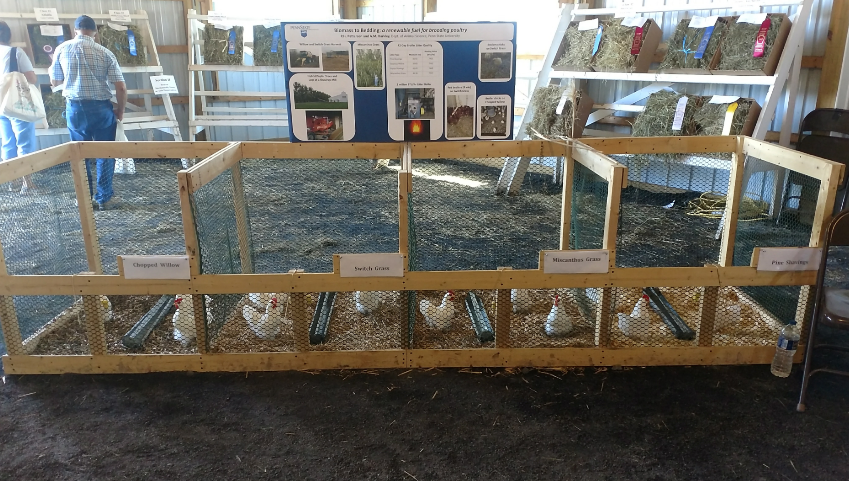
Figure 1: Biomass bedding display at Penn State’s Ag Progress Days 2017.
The involvement with the Association of Warm Season Grass Producers connected my research to Penn State’s Department of Agricultural and Biological Engineering, who in turn connected back with the Association. The contact with the Agricultural and Biological Engineering Department also presented the connection with SUNY College of Environmental Science and Forestry, which provided the willow chips for our second study. SUNY-ESF then in turn connected me with the NewBio team, whose members are interested in the results of this study and potential of biomass willow as a bedding material. These experiences and interactions have been enriching and would not have happened had it not been for these two projects.
Project Outcomes
Working with this project has revealed that there is currently a disconnect between supply and demand, limiting the use of these materials across the industry for both biomasses tested. There seems to be an interest in Miscanthus grass among farmers in the region, since it has been used very successfully by some farms. Although switchgrass is similar, it hasn’t yet benefitted from that same foothold. Willow is even more of an unknown product, considering its unique characteristics and relative difficulty to obtain.
That being said, the trials completed with the aid of this grant have helped create guidelines for these products that will allow more successful adoption of both materials. Although prior research has indicated that larger particle sizes of biomass grasses result in deceased performance and bird welfare, there is now a standard to follow, proven by both a pen and field trial, which has determined the most effective particle size for bedding application. Willow has been successfully used as a bedding material, though this trial has indicated some limitations that should be considered before application. Because of the success of these two beddings, both can be part of a larger sustainable system that can provide stability to both broiler and biomass growers in a fluctuating bedding market.
This project provided results that have the ability to impact agriculture in a big way. Growing biomass on or near the farm has a plethora of benefits. Having secure bedding material supplies has the potential to increase farm profitability and anticipated success, as the material will be consistent over purchasing it from various sources to follow either pricing or availability.
However, cost is one of the major factors preventing these products from being widely adopted. If shipping from outside the local area, the price switchgrass and willow growers would have to charge to be competitive with kiln dried softwood shavings may not bring them in enough profit to make it worth their time. This may hinder the adoption of these materials that are not grown locally. However, it may also prompt broiler growers to grow their own biomass on farm or advocate for it to be grown locally in order to achieve the best prices, though this likely won’t occur until it’s been proven successful in houses under their management.
This project was exciting because my advisor and I were able to quantify the commercial success of two alternative beddings that we knew had potential. He had been working with willow for years in a pen-trial setting, while I’d just finished a pen trial using switchgrass, which was a new bedding to be tested by our lab. Both willow and switchgrass have the potential to be produced on farm, and have other uses including vegetative buffers, putting marginal land into production, and carbon sequestration. Now having a sustainable model of growing biomass on-farm, using it successfully as bedding, then either using it as fuel or fertilizer, a new direction in research will attempt to quantify how this can result in a more sustainable farming system than the current model.
Outreach connections made throughout the course of this project have developed my understanding of the number of people involved in sustainable agricultural research. I now have a greater appreciation for those that promote and practice it and have become a promoter myself, along with my advisor, who has promoted these practices for quite some time.
One of the larger lessons learned through this experience was that building a network of those involved with production or end use will result in a more thorough evaluation of all aspects of a project. Only staying to those contacts outlined in the original grant would have still put forth a good evaluation of the beddings, but with the additional connections, there is now a better idea of pricing, availability, and acceptability. Getting the information out to as many audiences who are willing to listen have furthered the spread of information. I strongly believe this is what resulted in such success of this project.
Information Products
- Biomass for Bedding Fact Sheet
- Switchgrass as Bedding for Small Flocks
- How physical properties of biomass grasses influence their performance as a bedding material for broiler chickens
- Commercial Application of Switchgrass as Renewable Alternative Bedding for Broilers in a Single-Cycle Production System
- Vegetative Buffers: From Biomass to Bedding